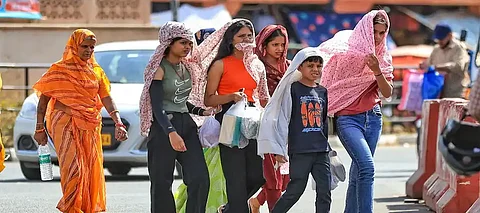

It's official—Bathinda is baking. On June 11, this dusty Punjab town recorded a sizzling 47.6°C, notably the hottest temperature in the area so far this summer. That's not merely five degrees higher than the seasonal average—it's also the newest in a series of unprecedented heat waves that people are already dreading annually.
And if you're wondering why it always seems to be this city that feels like the inside of an oven, you're not alone.
The initial two weeks in June did not arrive with surprises—except perhaps the universally merciless heat. Each day, the mercury seemed to dance between 40°C and 41°C, until this week when it went on a sudden leap. But for the people of Bathinda, this sort of surge is not unusual. The city reached 47.5°C in 2020, and 47.3°C in 2014. It's as if the summers here have a competition among themselves.
First of all, Bathinda is right in the center of a semi-arid region of Punjab. It doesn't get much rain—only 20 to 40 cm annually—and has open flat land with minimal natural cover. That means that the sun pounds away with no obstacle in the way, warming up the ground and air quickly, particularly during May and June.
Come summer, and the air becomes crisp, dry, and slightly brutal. Humidity remains low, and warm winds blow through the city, typically after dark. But rather than cooling the air, they tend to bring dust rather than relief. With fewer clouds and less moisture in the atmosphere, temperatures climb quickly—and remain so.
Bathinda has been growing, with new buildings rising up, but not nearly enough trees to counter them. That makes certain areas of the city function like heat traps, absorbing the sun during the day and emitting it slowly at night. Concurrently, over the last few decades, there's been a move toward intensive agriculture, which has removed natural cover that used to keep things cool. Combined, it's a formula for increasing heat.
Besides, the air and soil of the city are under stress. The industries, chemical farming, and indiscriminate disposal of waste have all weakened Bathinda's environment. With less water body and pond areas and decreasing green cover, the city has fewer natural shields to buffer the blow of heat.
Bathinda is not alone in the fight against the heat. On the same day, Sirsa in Haryana posted 46.2°C. But the trend's all too familiar—year after year, Bathinda sits atop the temperature charts. Other cities like Chandigarh and Ludhiana have been coping a bit better, with temperatures during the day ranging around 43°C to 44°C. But the difference makes a huge amount of difference on the ground.
If you had been expecting the clouds to roll in shortly, the weather bureau has some bad news. Heatwave conditions are likely to persist until mid-June, with day temperatures hovering perilously near 47°C in Bathinda and adjoining districts. The first glimmer of hope of respite is associated with the arrival of the monsoon—now estimated to hit the area after June 15.
It's not the temperature—it's the larger context. The city is located at the crossroads of rough geography, climate extremes, and human interference. That synthesis is driving Bathinda deeper into the red zone year after year. And unless there is a real turning point in how we deal with land, water, and urban expansion, this is not a one-off—it could be the new normal.